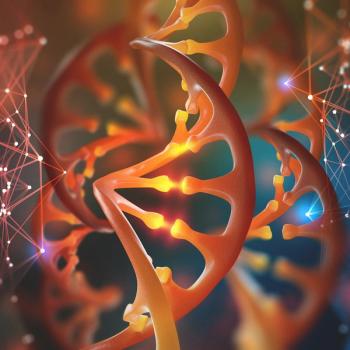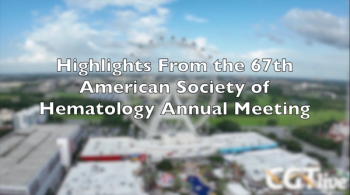
The Future of NSCLC: Molecular Profiles Guiding Treatment Decisions
The authors of "ALK-Targeted Therapy for Lung Cancer: Ready for Prime Time," in this issue of ONCOLOGY, address the newest developments in the field of targeted therapies for advanced non–small-cell lung cancer (NSCLC).
The authors of "
The use of ALK inhibitors for patients with EML4-ALK fusion is another success story. Although it is relevant only for 2%–7% of all unselected NSCLC patients,[2] the impact of ALK inhibitors for this select group of patients is substantial. The results of the first-in-human clinical trial with the ALK inhibitor crizotinib were presented at the 2010 meeting of the Americal Society of Clinical Oncology, during the plenary session. EML4-ALK fusion patients treated with crizotinib experienced a 57% response rate and an estimated progession-free survival rate of 72% at 6 months.[2] The drug was well tolerated, with only mild gastrointestinal and visual adverse events reported. The review article by Husain and Rudin summarizes clearly and succinctly the latest information and progress regarding ongoing and recently completed clinical trials with crizotinib. The ALK inhibitors hold significant promise for the future-especially in NSCLC patients with EML4-ALK fusion, ALK-amplified patients, and neuroblastoma patients with gain-of-function mutations of ALK. As briefly mentioned and outlined in
A number of conceptual and technical issues may confound the correlation between EML4-ALK fusion gene detection and response to crizotinib or other ALK inhibitors. The best method for analysis of tumor material for detection of the fusion gene has not been established yet, although fluorescence in situ hybridization (FISH)[3] has been used in clinical trials. Reverse transcriptase polymerase chain reaction (RT-PCR) amplification[4] and immunohistochemistry (IHC)[5] from archival formalin-fixed, paraffin-embedded tissue has also been evaluated, and assays are being developed. In the meantime, the common use of fine-needle aspirates (FNAs) for diagnosis, which are often insufficient for molecular analysis, must be amended, as FNAs may result in missed opportunities for detection of this molecular abnormality. It is also notable that detection of the fusion gene in tumor specimens collected at the time of initial diagnosis will not be sufficient to provide information about mutations that may develop subsequent to exposure to multiple courses of chemotherapy, and that repeated biopsies may be necessary after tumor progression occurs.
Primary and secondary resistance
In the crizotinib trial, 6 of 82 treated patients exhibited primary resistance. The mechanisms by which this occurs are unclear, but secondary mutations or alternative pathways of signal transduction are likely culprits. Choi et al have reported on two de novo mutations in EML4-ALK patients with NSCLC: C1156Y and L1196M.[6] Although both mutations confer resistance to crizotinib, the mutation of L1196M is defined as a "gatekeeper mutation" and likely prevents binding of crizotinib to ALK, whereas the C1156Y mutation is less dramatic in terms of its resistance effect. Inevitably, additional mutations are likely to be discovered, and their clinical effects against tyrosine kinase inhibitor resistance will need to be defined. Secondary resistance mechanisms are also likely to be a significant problem. In NSCLC, we have previously witnessed development of EGFR tyrosine kinase inhibitor resistance with the secondary mutation of T790M in previously sensitive patients with the EGFR mutation.[7] The challenge for the next phase of discovery for ALK inhibitors will be focused on identifying and usurping mechanisms of resistance. As the authors have outlined, however, inhibiting the heat shock protein 90 (Hsp 90)-an emerging target for cancer therapy, owing to its important role in maintaining activity and stability of key oncogenic signaling proteins-is resulting in tumor regressions in patients who are resistant to crizotinib.[8]
Conclusions
The future of thoracic oncology is a hopeful and exciting one, with the era of molecular diagnostics ahead. It is likely that we will one day turn metastatic NSCLC into a chronic, and ultimately curable, illness. As our understanding of signaling pathways in NSCLC evolves, designer agents that target these aberrant pathways will likely prove more effective than older chemotherapeutic agents. Understanding the unique toxicities will be important, and educating treating oncologists about the management of these unique toxic profiles is crucial. Also, altering our standard practice of using FNAs to obtaining core lung tumor biopsies is a critical paradigm shift that is essential to furthering progress towards personalized molecular medicine.
Financial Disclosure: The authors have no significant financial interest or other relationship with the manufacturers of any products or providers of any service mentioned in this article.
References:
References
1. Pao W, Miller V, Zakowski M, et al. EGF receptor gene mutations are common in lung cancers from "never smokers" and are associated with sensitivity of tumors to gefitinib and erlotinib. Proc Natl Acad Sci U S A. 2004;101:13306-11.
2. Kwak EL, Bang YJ, Camidge DR, et al. Anaplastic lymphoma kinase inhibition in non-small-cell lung cancer. N Engl J Med. 2010;363:1693-1703.
3. Shaw AT, Yeap BY, Mino-Kenudson M, et al. Clinical features and outcome of patients with non-small-cell lung cancer who harbor EML4-ALK. J Clin Oncol. 2009;27:4247-53.
4. Martelli MP, Sozzi G, Hernandez L, et al. EML4-ALK rearrangement in non-small cell lung cancer and non-tumor lung tissues. Am J Pathol. 2009;174:661-70.
5. Mino-Kenudson M, Chirieac LR, Law K, et al. A novel, highly sensitive antibody allows for the routine detection of ALK-rearranged lung adenocarcinomas by standard immunohistochemistry. Clin Cancer Res. 2010;16:1561-71.
6. Choi YL, Soda M, Yamashita Y, et al. EML4-ALK mutations in lung cancer that confer resistance to ALK inhibitors. N Engl J Med. 2010;363:1734-9.
7. Pao W, Miller VA, Politi KA, et al. Acquired resistance of lung adenocarcinomas to gefitinib or erlotinib is associated with a second mutation in the EGFR kinase domain. PLoS Med. 2005;2:e73.
8. Normant E, Paez G, West KA, et al. The Hsp90 inhibitor IPI-504 rapidly lowers EML4-ALK levels and induces tumor regression in ALK-driven NSCLC models. Oncogene. 2011;1â6.
Newsletter
Stay at the forefront of cutting-edge science with CGT—your direct line to expert insights, breakthrough data, and real-time coverage of the latest advancements in cell and gene therapy.






























